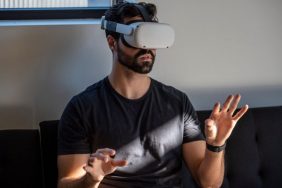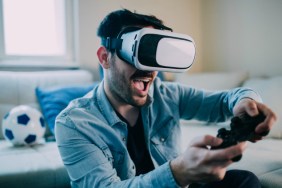I’m one of a very limited number of people who was genuinely left impressed by my experiences with stereoscopic 3D, more commonly known as “the 3D that makes your theater tickets slightly more expensive for seemingly no good reason.” Since Avatar popularized the technology (if only for a few fleeting months), outside of the odd horror movie such as My Bloody Valentine 3D it has largely been used to add an extra dollop of atmosphere to whatever you’re watching, and not to simply throw shit at you as you wore ill-fitting plastic Ray-Ban Wayfarers. Depending upon your point of view, that’s either a good or a bad thing.
But one area where it really did excel was in its implementation in video games, as the few who had been naive enough to purchase a 3D TV (myself included) can attest to. However, given that stereoscopic 3D had something of an image problem given its underwhelming impact upon cinema, convincing people that playing Motorstorm: Apocalypse in 3D really was a fantastic experience, and wasn’t just me being hyperbolic in order to justify a massive waste of both my time and money, was quite difficult. But once I forced those 3D glasses upon friends and family members’ heads, passed them the PS3 controller and watched their faces light up, I could bask in the glow of own smug self-satisfaction as they were forced to accept that I was right, they were wrong, and that 3D was the future.
Except it wasn’t. As I stood as the lone bastion of 3D gaming, I watched as the technology crumbled around me: Sony ditched its support of it with the PS4, thus spelling the end of its short life span on home consoles, while Nintendo also released a 2DS alternative to its 3DS, significantly downplaying the 3D functionality of its handheld console. Now my 3D TV has been forced to the confines of my bedroom, making way for a shiny 4K TV in my living room that definitely won’t prove to be a waste of money and absolutely will be supported by console manufacturers and film studios far into the future.
However, the problems stereoscopic 3D faced seem destined to also be encountered by virtual reality, in that it’s difficult to sell a product that’s reliant upon the user experiencing it in order for them to understand its capabilities. While there will be the odd risk-taker who’s willing to plump down a wad of cash on something that could well turn out to be a failed experiment, the vast majority of people are far more sensible and choose to reserve their money unless they’re given a solid reason to part ways with it. These are the people that VR is going to struggle to convince, and similar to stereoscopic 3D, there are a very limited number of ways in which they can market their product to the skeptical.
Trying VR out probably won’t lead to you suffering an existential crisis like this guy, but it certainly is impressive
The success of VR hinges upon a number of crucial factors, most prominently whether or not the likes of Oculus, HTC and Sony will be able to convince those who have yet to experience the tech into buying a pricey headset in order to try it out. In-store demonstrations and trying out someone else’s headset are the only two ways in which someone will be able to get a feel for what VR has to offer without actually buying a headset for themselves, significantly minimizing its reach considering This, of course, rings true for a wide variety of products, but what separates the Rift, the Vive and the PlayStation VR from other tech is that it is unproven and, as such, consumers have nothing to really compare it to.
Sony Computer Entertainment Inc. president Shuhei Yoshida spoke of how PlayStation VR will prove to be more successful than 3D TV, telling Polygon: “This is not the next 3D. This is totally different… [with VR] you are totally inside the game. You are in a virtual environment. That level of, quality of experience will convince people. You cannot get that experience in any other way. So that’s a clear difference.”
For all intents and purposes, Yoshida is right. While I haven’t had the chance to get my hands on the PlayStation VR, I have heard that it’s comparable with the Oculus Rift, and that technology is far more impressive than what is offered by stereoscopic 3D. But in this statement, Yoshida also outlines the inherent issue in trying to introduce VR to the mainstream – that users will need to experience the tech first in order to get an idea of its quality.

The PlayStation VR, formerly known as the Project Morpheus.
Virtual reality is the first consumer technology that can really brand itself as being completely unique in quite some time. Every product that has fought its way into the mainstream in recent years has had the benefit of being directly comparable to something else: an iPod was an MP3 player but more stylish and with more storage; an iPad a mid-way point between an iPhone and a notebook; a smartwatch a minimalist smartphone that you could strap to your wrist. Comparing the likes of the Oculus Rift to any previous technology dramatically undersells it, because there has never been anything else quite like it before. This makes the success of virtual reality more-or-less a complete crap shoot, likely hindered further by the inevitably relatively high price point of early models, along with the issue of the quality of the software that will support it during its teething period.
The PlayStation VR faces the sternest challenge in this regard. With its line of launch titles that have been announced thus far being underwhelming, this is somewhat concerning considering just how indifferent Sony has been in providing continued support for its past console peripherals – remember the Move? What about the EyeToy, or the PS Eye, or the PlayStation Camera? Sony likely hopes that you’ve forgotten about them.
While the PlayStation VR is undoubtedly a much bigger venture for the company, and one they’ll want to see succeed far more than their motion-controller wand and a few glorified webcams, outside of their consoles they have a habit of failing to match their hardware with vital software, which will spell the beginning of the end for the PlayStation VR if they opt to go down this unfortunate route once again. With its price point touted as being around $400, it will basically carry the same price tag as an actual gaming platform. This is a major hurdle that can only be overcome by actually giving people a reason to plump down their money upon launch, and if Sony fails to do so – as has been the case with every peripheral they’ve released thus far – then the PlayStation VR is ultimately doomed to fail.

The HTC Vive.
In this regard, the Oculus Rift and the HTC Vive have a brighter future. Given that they have the benefit of releasing on PC, an open platform, there are bound to be many more VR titles that will be playable on these headsets than there will be on the PlayStation VR. With a broader range of developers releasing games on the platforms, from both the triple-A to the independent, the Oculus Rift and HTC Vive are bound to receive far more support than Sony’s own offering, and as such they will be granted the time to eventually broaden their reach beyond the niche audience they’re likely to solely appeal to at launch. This is an opportunity I don’t believe will be afforded to the PlayStation VR, and will likely stand to make supposed VR revolution a very limited race.
Oculus founder Palmer Luckey acknowledges that this could well be the case. Speaking to GamesRadar, he said: “It’s very clear that VR will take off – it’s just a matter of time. Will it take one year, five years, ten years before it’s mainstream? I can’t say. It’s going to depend on how fast we can push this technology, but I think that if you told someone ‘Hey what if you could put on a pair of glasses and be anywhere in the world with perfect quality?’, very few people would say ‘Oh no, that’ll never take off’.”
Hopefully I’m proven wrong and the PlayStation VR exceeds expectations, standing side-by-side with the Oculus Rift and HTC Vive as part of a VR takeover that will leave people such as myself looking like idiots for ever questioning the technology’s ability to resonate with a wide audience. But at the moment, I just can’t see it happening. The Rift and Vive may prove to be a popular new gadget for owners of PCs capable of utilizing it, but considering the cost of entry is reliant upon consumers purchasing a reasonably powerful PC rig and a headset that could wind up costing them over $1,000, it seems unlikely that VR is going to penetrate the pop culture zeitgeist in the near future. Sony has an opportunity to broaden this reach to more “casual” appreciators of tech with the PlayStation VR, but their inconsistent history of releasing gaming hardware outside of their PlayStation consoles leads me to believe they’ll fail to step up to the plate. Maybe the VR revolution is coming, but I can’t see it happening in 2016.







